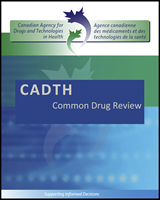Except where otherwise noted, this work is distributed under the terms of a Creative Commons Attribution-NonCommercial-NoDerivatives 4.0 International licence (CC BY-NC-ND), a copy of which is available at http://creativecommons.org/licenses/by-nc-nd/4.0/
NCBI Bookshelf. A service of the National Library of Medicine, National Institutes of Health.
The objective of this systematic review is to examine the beneficial and harmful effects of cobicistat-boosted darunavir (DRV/COBI) 800 mg/150 mg for the treatment of HIV-1 infection in antiretroviral treatment-naive and treatment-experienced patients without darunavir (DRV) resistance-associated mutations (RAMs).
Contents
- Clinical Review Report
- ABBREVIATIONS
- EXECUTIVE SUMMARY
- 1. INTRODUCTION
- 2. OBJECTIVES AND METHODS
- 3. RESULTS
- 4. DISCUSSION
- 5. CONCLUSIONS
- APPENDIX 1 PATIENT INPUT SUMMARY
- APPENDIX 2 LITERATURE SEARCH STRATEGY
- APPENDIX 3 EXCLUDED STUDIES
- APPENDIX 4 DETAILED OUTCOME DATA
- APPENDIX 5 SUMMARY OF DRV/COBI PHARMACOKINETIC STUDIES (TMC114IFD1001 AND TMC114IFD1003)
- APPENDIX 6 SUMMARY AND CRITICAL APPRAISAL OF MANUFACTURER-SUBMITTED COMPARATIVE ANALYSIS
- REFERENCES
- Pharmacoeconomic Review Report
- CDEC Final Recommendation
This report was prepared by the Canadian Agency for Drugs and Technologies in Health (CADTH). Through the CADTH Common Drug Review (CDR) process, CADTH undertakes reviews of drug submissions, resubmissions, and requests for advice, and provides formulary listing recommendations to all Canadian publicly funded federal, provincial, and territorial drug plans, with the exception of Quebec.
The report contains an evidence-based clinical and/or pharmacoeconomic drug review, based on published and unpublished material, including manufacturer submissions; studies identified through independent, systematic literature searches; and patient-group submissions. In accordance with CDR Update — Issue 87, manufacturers may request that confidential information be redacted from the CDR Clinical and Pharmacoeconomic Review Reports.
The information in this report is intended to help Canadian health care decision-makers, health care professionals, health systems leaders, and policy-makers make well-informed decisions and thereby improve the quality of health care services. The information in this report should not be used as a substitute for the application of clinical judgment with respect to the care of a particular patient or other professional judgment in any decision-making process, nor is it intended to replace professional medical advice. While CADTH has taken care in the preparation of this document to ensure that its contents are accurate, complete, and up-to-date as of the date of publication, CADTH does not make any guarantee to that effect. CADTH is not responsible for the quality, currency, propriety, accuracy, or reasonableness of any statements, information, or conclusions contained in the source documentation. CADTH is not responsible for any errors or omissions or injury, loss, or damage arising from or relating to the use (or misuse) of any information, statements, or conclusions contained in or implied by the information in this document or in any of the source documentation.
This document is intended for use in the context of the Canadian health care system. Other health care systems are different; the issues and information related to the subject matter of this document may be different in other jurisdictions and, if used outside of Canada, it is at the user’s risk. This disclaimer and any questions or matters of any nature arising from or relating to the content or use (or misuse) of this document will be governed by and interpreted in accordance with the laws of the Province of Ontario and the laws of Canada applicable therein, and all proceedings shall be subject to the exclusive jurisdiction of the courts of the Province of Ontario, Canada.
CADTH takes sole responsibility for the final form and content of this document, subject to the limitations noted above. The statements and conclusions in this document are those of CADTH and not of its advisory committees and reviewers. The statements, conclusions, and views expressed herein do not necessarily represent the views of Health Canada or any Canadian provincial or territorial government. Production of this document is made possible by financial contributions from Health Canada and the governments of Alberta, British Columbia, Manitoba, New Brunswick, Newfoundland and Labrador, Northwest Territories, Nova Scotia, Nunavut, Ontario, Prince Edward Island, Saskatchewan, and Yukon.
- NLM CatalogRelated NLM Catalog Entries
- [Darunavir/cobicistat monotherapy. Experience in a tertiary hospital].[Rev Esp Quimioter. 2016][Darunavir/cobicistat monotherapy. Experience in a tertiary hospital].Yunquera-Romero L, Asensi-Díez R, Del Rio-Valencia JC, Muñoz-Castillo I, Castaño-Carracedo MA. Rev Esp Quimioter. 2016 Dec; 29(6):308-317. Epub 2016 Oct 11.
- Phase IIIb, open-label single-arm trial of darunavir/cobicistat (DRV/COBI): Week 48 subgroup analysis of HIV-1-infected treatment-nave adults.[J Int AIDS Soc. 2014]Phase IIIb, open-label single-arm trial of darunavir/cobicistat (DRV/COBI): Week 48 subgroup analysis of HIV-1-infected treatment-nave adults.Tashima K, Crofoot G, Tomaka FL, Kakuda TN, Brochot A, Vanveggel S, Opsomer M, Garner W, Margot N, Custodio JM, et al. J Int AIDS Soc. 2014; 17(4 Suppl 3):19772. Epub 2014 Nov 2.
- Review Rationale and clinical utility of the darunavir-cobicistat combination in the treatment of HIV/AIDS.[Drug Des Devel Ther. 2015]Review Rationale and clinical utility of the darunavir-cobicistat combination in the treatment of HIV/AIDS.Putcharoen O, Do T, Avihingsanon A, Ruxrungtham K. Drug Des Devel Ther. 2015; 9:5763-9. Epub 2015 Oct 23.
- Subgroup analysis of virological response rates with once- and twice-daily darunavir/ritonavir in treatment-experienced patients without darunavir resistance-associated mutations in the ODIN trial.[HIV Med. 2013]Subgroup analysis of virological response rates with once- and twice-daily darunavir/ritonavir in treatment-experienced patients without darunavir resistance-associated mutations in the ODIN trial.Sension M, Cahn P, Domingo P, Hodder S, Opsomer M, Lathouwers E, Van de Casteele T, Tomaka F. HIV Med. 2013 Aug; 14(7):437-44. Epub 2013 Mar 10.
- Review Pharmacokinetics and pharmacodynamics of boosted once-daily darunavir.[J Antimicrob Chemother. 2014]Review Pharmacokinetics and pharmacodynamics of boosted once-daily darunavir.Kakuda TN, Brochot A, Tomaka FL, Vangeneugden T, Van De Casteele T, Hoetelmans RM. J Antimicrob Chemother. 2014 Oct; 69(10):2591-605. Epub 2014 Jun 20.
- Darunavir/Cobicistat (Prezcobix)Darunavir/Cobicistat (Prezcobix)
- Aripiprazole (Abilify): Depression, Major Depressive Disorder (MDD)Aripiprazole (Abilify): Depression, Major Depressive Disorder (MDD)
- Aclidinium Bromide (Tudorza Genuair)Aclidinium Bromide (Tudorza Genuair)
Your browsing activity is empty.
Activity recording is turned off.
See more...
